At age 19, Brian Jones seems the perfect example of Gen Z success without college—and also, perhaps, of the perils that lie in that path.
During his high school years in Memphis, Tennessee, Jones began training as a barber, eventually becoming so adept at cutting hair that he decided to pursue it full-time when he graduated in 2020 rather than continue his education. He quickly built a client book that included a smattering of NBA players and other celebrities who discovered videos of his cuts on Instagram. His posts @ wheathead_, displaying precocious skill and creativity, sometimes earned millions of views.
Since the heady first days of his launch, however, the business has taken a turn, as soaring inflation prompted clients facing higher prices for food and gas to cut back on less necessary expenses, like pricey haircuts (at Jones' shop, the going rate is $75 for a cut, $90 if you add a beard trim). Where once he was working 12- to 15-hour days, now Jones sometimes has no appointments at all. To supplement his income, he has launched an online barber school, and is thinking about jobs that could be a last resort, like selling shoes and mowing lawns—things he did to earn money before he cut hair. Jones says, "I'm trying to thrive, but as of now I'm just surviving."

Three years into the pandemic, after two years of isolation, shuttered schools and virtual commencements, high school graduates like Jones from the classes of 2020, 2021 and beyond—call them Generation COVID—are shunning college in record numbers. Enrollment is down nearly 10 percent over the past two years, a loss of 1.4 million students pursuing degrees. At TikTok, where variations on the hashtag #NotGoingToCollege have racked up more than 30 million views, young people argue "my career doesn't need college" and talk about starting their own businesses (often as influencers).
Overall, just 51 percent of Gen Z teens are now considering a four-year degree, according to a survey this year by the nonprofit ECMC Group—a 20-point drop since May 2020. "Gen Z students are sharp," says Jeremy Wheaton, the organization's former president and CEO. "They're thinking about things such as the return on their time and dollar investment."
Their calculations, however, could be misleading.
Paying high tuition and taking out student loans to pursue a degree may not feel like the smartest move when the labor market is strong, jobs are plentiful and even warehouse positions at Amazon pay $17, $18 or more an hour. But the gap between what young workers with a high school diploma make versus what people of the same age with a college degree earn has actually grown over the pandemic years, not diminished. And if the economy continues to cool and jobs evaporate, less educated workers face a much higher risk of unemployment, as the recent experiences of the 2008 and 2020 recessions made clear—not to mention far poorer long-term prospects.
In fact, behind the upbeat TikToks and occasional very public success stories, there are already troubling signs that the kids of Generation COVID aren't alright.
For one, the idea that they're all rejecting college because entry-level jobs pay much more than they used to turns out to be something of a myth: Bogged down perhaps by a pandemic malaise, as many as one in six young adults ages 18 to 24 are neither in school nor working, according to an analysis for Newsweek by Lightcast, a data-driven labor market consulting firm. In other words, they're doing...nothing.
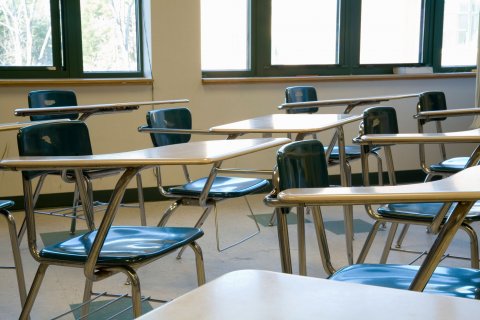
Disconnected from the mainstream economy, these young adults risk staying unemployed and under-educated, struggling to catch up with their peers. "People who are not working nor in school are potentially missing out on some really formative skill building years," says Lightcast senior economist Layla O'Kane. Studies suggest these young people may face lifelong consequences, including lower wages throughout their careers, higher risk of unemployment and greater odds of poor health.
The young adults now working those reasonably well-paid warehouse jobs or chasing fame on the Internet might not be better off in the long run either. Entry-level jobs often don't instill the skills necessary for better-paying jobs down the road, experts say, and the lack of higher education could stifle young people's advancement. Economist Harry Holzer of Georgetown University says, "It might end up being a real mistake for people to forgo the investment of college because of the lure of that short-term gain."
The cost to the country as a whole could be great as well: widening wealth and racial disparities, more than $1 trillion in lost economic output, according to one study, and diminished competitiveness with global rivals like China, where college enrollment is still rising. And the costs, for both today's young adults and the nation, will build over time.
"By the 2060 census," says Michael Hicks, director of the Center for Business and Economic Research at Ball State University in Muncie, Indiana, "you will see a lifetime impact on this generation."
An Uneven Toll
The pandemic didn't cause the current decline in college enrollment, which started years ago with a demographic shift: A sharp drop in births after the Great Recession led to a smaller number of college-age young adults today. But COVID did kick that decade-long slide into much higher gear. More than one in four high school seniors from the class of 2022 say they've "changed their post-secondary-school plans since the start of the pandemic," according to a survey by the nonprofit YouthTruth, with less than half now planning to attend a four-year college.
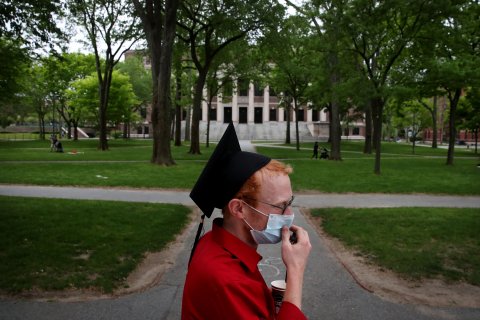
Especially troubling: The decline has been uneven, with students from lower-income families and communities of color opting out of college at far higher rates than others, worsening the existing gaps in educational attainment between whites and Asians versus other minorities.
According to the National Student Clearinghouse, enrollment by Black freshmen is down 18.7 percent since the spring of 2020, roughly double the overall 9.4 percent drop. Since 2010, the college-going rate for Black high school graduates has dropped from 66 percent to 54 percent. Hispanic college-going, which had been steadily rising since 2010, is sliding as well, going from a high of 69 percent in 2015 to 60 percent in 2020. Among white students, college-going dropped just three points, from 70 percent to 67 percent, while the rate among Asians fell one point, from 87 percent to 86 percent.
"The last two years of the pandemic pretty much wiped out five years of progress," says Deborah Santiago, CEO of Excelencia in Education, a nonprofit that advocates for Latino college access and success.
Some cities have been harder hit than others. In Nashville, Tennessee, where about 70 percent of public school students are Black or Hispanic, six of the city's public high schools had college-going rates of less than 30 percent in 2021, says Bob Obrohta, executive director of the Tennessee College Access and Success Network (TCAN). That's compared to zero pre-pandemic, when college-going rates peaked at 57 percent in 2016.
The lowest rates were among the city's minority students, with just 29 percent of Latino students and 42 percent of Black students going to college, compared to 66 percent of Asians and 59 percent of whites. "We have [racial] equity gaps now that are at the highest they've ever been," says Obrohta.
Surge in the Disconnected
Some see an upside in the enrollment trends, if it means young people are avoiding burdensome student loans and finding better opportunities elsewhere.
"College is no guarantee for success, and there can be severe consequences if you make the wrong decisions about when you go, where you go and what you study," says Jason Tyszko, vice president for the U.S. Chamber Foundation's Center for Education and the Workforce. "This country has nudged and pushed a lot of people into a track that has not served them well.
At about a third of the nation's colleges, according to the Georgetown University Center on Education and the Workforce, a majority of students end up earning less than the typical high school graduate 10 years later. Student debt, meanwhile, averages $26,100 for graduates of four-year public universities and $16,800 for public two-year colleges, according to the Department of Education.
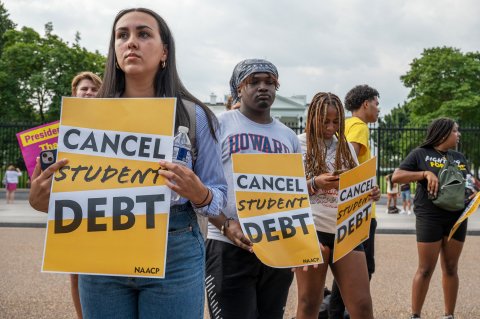
Moreover, Tyszko says, businesses are increasingly shedding requirements that potential hires have a college degree. IBM, for instance, announced in 2021 that it had stripped BA requirements from more than half of its job postings. "Talent is so scarce companies are willing to take someone who is nowhere near the qualification level and say we'll get you where you need to be," says Tyszko.
Landing those jobs straight out of high school, though, is still tough—or, apparently, any job. According to Lightcast, the number of young adults ages 18 to 24 who are neither in school nor working surged by about 1 million from 2019 to 2021. Young men in particular are more likely to be disconnected; the percentage of young men not in school or working jumped from 12.4 percent in 2019 to 16.7 percent in 2021, according to Lightcast. And the racial discrepancies are startling, with Black and Hispanic young people by far the most likely to be disconnected: Nearly one in four Black youth (23 percent) and about 17 percent of Hispanic youth are not working or in school, versus 15 percent of white youth.
The consequences of disconnection can be severe, says Kristen Lewis, director of the nonprofit Measure of America. In a 2018 study comparing the life trajectories of disconnected young adults versus those who stay on course with school and work, Lewis found that, by the time they reached their mid-to-late 30s, the median family income of someone who'd been disconnected for two or more years as a young adult was less than half that of someone who'd stayed engaged in school or work—$31,000 vs. about $78,000. The formerly disconnected adults were also much less likely to be homeowners and 40 percent less likely to be employed. Only about half reported being in "excellent" or ''very good" health, compared to seven in 10 for those who'd remained connected.
"Disconnected young people miss a critical window of human development," says Lewis. "It's a time when young adults build social skills and networks, they develop basic life skills, and they get the knowledge and credentials necessary to build a good career."
Disconnection also means that the skills young people do have atrophy rapidly, making them less likely to be employable in the future. "There could be a bit of a snowball effect if the skill building isn't happening now," says Lightcast's O'Kane, with workers facing higher barriers when they try to re-engage in the labor market. According to Lightcast, 37 percent of the top 20 skills employers want today for the "average" job are different from what they were in 2016, evidence of how rapidly the labor market is changing.
Society ultimately bears the cost. Disconnection also leads to dysfunction, including "increased criminal activity, increased drug use, and lower levels of educational attainment overall," according to a 2019 study by the Russell Sage Foundation. The children of disconnected parents are also more likely to be disconnected themselves, perpetuating intergenerational disadvantages. A 2012 study by the City University of New York and Columbia University estimated that every disconnected young adult burdens taxpayers by $13,900 per year in welfare benefits, Medicaid, criminal justice and other expenses, plus $37,450 in indirect costs for lost productivity and tax revenues.
'What's It Matter, Anyway?'
One force contributing to the surge of disconnection is the current mental health crisis among young adults, brought on by pandemic disruptions, family loss and economic hardship. More than one in three high schoolers reported "poor mental health" during the pandemic, and 44 percent reported "persistent feelings of sadness and hopelessness," according to a March 2022 report by the Centers for Disease Control (CDC). In 2009, by comparison, 26 percent of teens felt this way.
Advocates say they've noticed significant apathy and disengagement among the young adults they work with in thinking about their post-high school lives, the likely results of lingering trauma and isolation. "It's this underlying 'What's it matter, anyway?'" says Adam Yockey, senior director of high school and postsecondary initiatives at the Martha O'Bryan Center, a Nashville nonprofit that promotes college access for low-income youth. "When you ask them what their interests are, what they enjoy doing, the common answer is 'I don't know.'"
"We're wondering if it's because of a year and a half of virtual school and not being connected outside of their house...or two years without field trips, college visits, job shadowing opportunities or other things schools [would] typically be doing," Yockey says.
Lee Gray, senior director of school programs at the Oasis Center, another Nashville nonprofit that works with at-risk youth, says he and his team have tried to contact 2020 and 2021 graduates who didn't go to college, to encourage their return to school. They've made hundreds of phone calls and sent thousands of texts and emails, with little luck "We've had a really hard time getting any significant number of folks to reengage in their education," he says. "It's so disheartening."
Student disengagement is likewise at crisis levels in Detroit. As many as 70 percent of Detroit public school students were "chronically absent" during the 2020-21 school year, according to a study by Wayne State University. As one result, the college-going rate among Detroit public high school graduates last year was a scant 46.6 percent, down nearly 9 points since 2017. According to Measure of America, the Congressional district that includes Detroit (Michigan's 14th district) had one of the nation's worst youth disconnection rates in 2020, at 25 percent.
"Detroit was hit really hard by the pandemic," says Cyekeia Lee, executive director of the Detroit College Access Network (DCAN). "This is a major city where you already had to deal with poverty and crime and low wages and all the things that will impact a student's household."
Lee says her organization struggled to gin up student participation in its programs for high schoolers this summer, which include SAT prep and a "college fit" initiative to help students start thinking about schools. "We're like, do we need to be on TikTok? What do we need to do to reach students?" she says.
In sharp contrast to the students of urban Detroit, more than 95 percent of the class of 2022 at Bloomfield Hills High School in the nearby predominantly white, affluent suburb of Bloomfield Hills, Michigan, are headed to four-year schools this fall—underscoring experts' concerns about a growing racial divide in educational attainment. After about a 10 percent dip in college-going in 2020 and 2021, school counselor James Fogle says they're "seeing a shift back to pre-pandemic numbers."
The Growing College Premium
If the skeptIcs were rIght about the dImInIshing value of a college degree, the handwringing about the implications of declining enrollment could be more easily dismissed. But, in fact, the opposite is true: According to an analysis this year by the New America Foundation, the wage difference between college and high school graduates—the "college premium"—has actually grown since the start of the pandemic. In addition, New America found, young college graduates were only half as likely to be unemployed as people with a high school degree only.
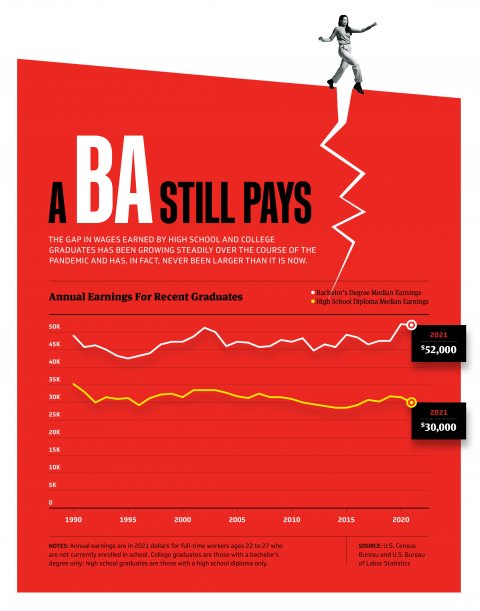
Graduates of four-year schools are also grabbing a growing share of the economy's "good jobs" (defined as paying at least $17 an hour), according to Georgetown University's Center on Education and the Workforce—a decades-long trend that researchers believe accelerated during the pandemic and gets bigger as people advance (or don't) in their careers. The most recent stats pre-date the pandemic but show the gap: In 2018, 56 percent of "good jobs" belonged to those with bachelor's degrees, versus just 20 percent for those with high school diplomas. By age 35, 80 percent of young adults with a bachelor's degree had landed "good" jobs, compared to 42 percent of those with just a high school diploma.
Globalization, automation and the decline of manufacturing have fueled the trend and it's the automation aspect that COVID has accelerated "as employers substitute workers with computers and robots that are unaffected by pandemics," according to a National Bureau of Economic Research report. Georgetown's Harry Holzer predicts many entry-level jobs—including the newly higher-paying ones, like those at Amazon warehouses—will fall victim to automation.
"People are developing robotics with increasing manual dexterity," he says. "The combination of self-driven vehicles and drones might end up doing a lot of the work."
Even skilled trades aren't immune from technological advances that will result in fewer jobs for workers without college degrees, argues Ball State University's Michael Hicks. "There's always technology in the building trades that eliminates jobs," he says, citing plumbing as an example. "Productivity gains in plumbing mean we have fewer plumbers than we did 20 years ago despite having more homes," Hicks notes. "Flexible pipes mean you can rely on less skilled plumbers. You don't have to sweat every joint like you did in the 1950s."
Then too, the entry-level jobs that high schools grads are able to land don't seem to provide much opportunity to advance to better-paying work as they get older. According to a Lightcast study last year, nine out of 10 young workers without a college degree get their start in sales, administrative support, food service or transportation. After five years in the labor force, the study found, nearly half were "stuck" in the same or similar jobs, earning as much or less than when they were first hired.
Given these realities, the young adults lured away from college by today's higher wages for entry-level work could be walking into a trap. "Who doesn't want more money in their life, and who doesn't want that now?" says DCAN's Cyekeia Lee. "But 10 years from now, you don't want to still be making $15, $16, $20 an hour if you could be making much more."
Those future prospects could become even more precarious if, as widely anticipated, the economy falters. Historically less educated workers have fared the worst during downturns. During the Great Recession, for instance, unemployment peaked at 11.9 percent for high school graduates in 2010, compared to 5.1 percent for those with a bachelor's degree or higher. And the pattern repeated itself in the COVID recession of 2020.
The U.S. Chamber Foundation's Jason Tyszko acknowledges that companies' current willingness to relax hiring standards and train less-educated workers might not persist if the economy deteriorates and unemployment rises. "Once employers have a lot more choice in terms of labor, we just don't know," he says.
The Oasis Center's Lee Gray expects young workers to suffer the most. "When the bottom falls out, they're going to fall far," he says.
A $1.2 Trillion Cost to Society
It's not just the young workers of generation COVID who may lose out financially and socially. In the long run, declines in college-going could also do serious damage to the U.S economy.
America was facing a shortage of skilled workers even before the pandemic. A 2019 study led by former Congressional Budget Office Director Douglas Holtz-Eakin concluded that shortages of workers with some college education or a BA could result in nearly $1.2 trillion in lost economic output over the next decade. In particular, Holtz-Eakin concluded, the economy will be short about 8.6 million college graduates and nearly 800,000 workers with an associates' degree or some college.
Some metro areas are already feeling this need acutely. In Detroit, for instance, technological advances have transformed the auto industry into a marriage of manufacturing and high tech, especially as robots take over the assembly line and cars become increasingly sophisticated.
"The line between what is a car and what is a computer has essentially gone away," says Sandy Baruah, president and CEO of the Detroit Regional Chamber. "The auto industry a generation ago highly prized mechanical engineers. Now you need people who are not just mechanical engineers but also electrical engineers and software engineers. People need fluency in all three of these areas to be successful."

Fixing the skills gap is such a major concern for Detroit-area businesses that the Detroit Regional Chamber spends nearly a quarter of its $24 million annual budget on education and workforce development initiatives. Among these efforts is Detroit Drives Degrees, which creates partnerships with area community colleges to re-engage adult learners; Detroit Promise, a scholarship program that picks up tuition and fees at Michigan two- and four-year schools not covered by other student aid; and Detroit Reconnect, which offers debt forgiveness to adult students who've quit school so they can resume their studies.
Among the Detroit Regional Chamber's community college partners is Henry Ford College in Dearborn, Michigan. Enrollment dropped from about 5,100 last year to about 4,400 this summer, says Holly Diamond, vice president of student affairs. To stem the tide, the school has rolled out a variety of initiatives to attract new students and retain the ones they have.
In addition to the debt forgiveness program it offers as part of Detroit Reconnect, the college provides a number of services to help students cope with everyday financial challenges that could derail their studies. "We give away Chromebooks, and we provide bus passes for students who need transportation," Diamond says. "We have just-in-time emergency aid so if somebody says they have a flat tire, we provide the funds—anything to help them stay on track."
Other colleges across the country are also embracing these kinds of innovations, seeing the challenges posed by the pandemic as a catalyst for broader reforms. "Higher ed needs to reestablish its value and find ways to highlight the importance and the value of a degree," says Ahmad Ezzeddine, vice president for academic student affairs and global engagement at Wayne State University in Detroit. "We need to adapt to the changing demographics, the changing workforce, the changing landscape."
Among other efforts, Ezzeddine says, Wayne State launched "Warrior 360," which partners at-risk students with "success coaches" to provide academic and social support. More courses are now online and offered year-round or at night to accommodate working students' schedules. In addition, the university has beefed up its summer camps for K-12 students and outreach to area high schools. "We have faculty go and talk about careers in engineering and science, hopefully planting that seed," says Ezzeddine.
Organizations like College Possible, a St. Paul, Minnesota-based nonprofit focused on increasing college access and success for low-income students, are also working to connect young people with options that help them continue their education after high school. One program offers "near-peer coaching" by young adult volunteers working with the federal government's AmeriCorps national service program. Coaches provide advice on everything from financial aid to navigating culture as a first-generation student. "It's almost like an older sibling-younger sibling relationship," says senior vice president Austin Buchan.
College Possible matches students with coaches during their junior year of high school and provides support through college graduation. It reaches as many as 30,000 students per year in eight locations nationwide, including Chicago, Milwaukee, Omaha and Philadelphia. A three-year study of College Possible's Milwaukee program found that participating students were 30 percent more likely to enroll in college immediately after high school and 30 percent more likely to choose a four-year school.
Overall, the organization says, 85 percent of its students persist in college after their first year and are three times more likely to graduate than their peers. And because of the financial coaching students receive, one in four graduate debt-free.
Show Them the Money
Affordability is perhaps the No. 1 reason many young adults, especially low-income and minority students, believe college "isn't worth it." Until that core issue is addressed, experts say, the lure of an immediate paycheck, weighed against spending a lot of money or going into debt to boost future wages, will be hard for many financially-strapped students to pass up.
Topping the solutions' wish list: a doubling of the federal Pell grant for low-income students to $13,000 a year—an idea endorsed by more than 100 educational organizations, including the American Council on Education, the American Teachers Federation and the National Association of Colleges and Employers. The LOAN Act (Lowering Obstacles to Achievement Now), introduced by House Democrats in September, would achieve the goal over a five-year period but its chances of passage are unclear.
Meanwhile, a growing number of states and cities are trying to fill the void with initiatives like "Promise" programs, which provide free tuition for two- and sometimes four-year college. Nonprofit College Promise, which advocates for these efforts, lists 362 such programs nationwide, including 33 that are statewide. Maryland's Community College Promise program, for instance, offers up to $5,000 a year for tuition and fees not covered by other aid to students who maintain at least a 2.5 GPA and come from households earning less than $150,000 a year ($100,000 for single-parent families).
Some schools have teamed up with employers to defray costs and encourage the pursuit of a degree. The University of Memphis, for instance, has partnered with subsidiaries of FedEx to offer Learning inspired by FedEx (LiFE), a tuition assistance program in which the university directly bills the company so students face no upfront costs. Courses are exclusively online and self-paced, and workers can earn up to 30 hours of college credit for company trainings that align with their major.
Since its launch in 2018, the program has enrolled about 3,000 workers, says FedEx Express vice president of human resources Robbin Page. Fifty-five employees have since earned their bachelor's degrees, including Chris Massey, 27, who started out as a package handler but has since been promoted to the business side as a data analyst. "That degree opened up some doors for me," he says.
Programs like these could be valuable options when young adults who've skipped college for now rethink their paths. And if more schools follow the lead of institutions like the University of Memphis, the kids of Generation COVID who risk falling behind will have ample opportunities to catch up.
Advocates like the Oasis Center's Lee Gray say they'll be ready to make that happen. "It doesn't matter if you're 20 or 29 or 35 or 40," he says. "When it is time for you to re-engage, we will be right here for you."
This story was produced with support from the Education Writers Association.
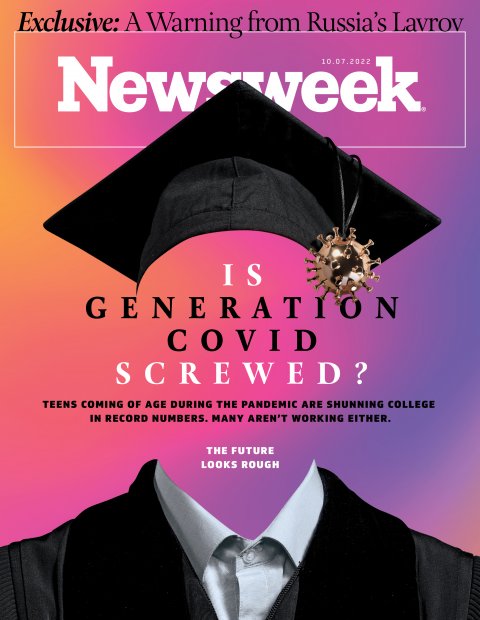
About the writer
Anne KimTo read how Newsweek uses AI as a newsroom tool, Click here.